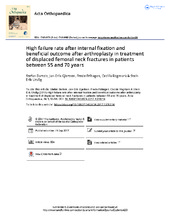| dc.contributor.author | Bartels, Stefan | en_US |
| dc.contributor.author | Gjertsen, Jan-Erik | en_US |
| dc.contributor.author | Frihagen, Frede Jon | en_US |
| dc.contributor.author | Rogmark, Cecilia | en_US |
| dc.contributor.author | Utvåg, Stein-Erik | en_US |
| dc.date.accessioned | 2018-03-26T12:49:54Z | |
| dc.date.available | 2018-03-26T12:49:54Z | |
| dc.date.issued | 2018 | |
| dc.Published | Bartels S, Gjertsen JE, Frihagen FJ, Rogmark C, Utvåg SE. High failure rate after internal fixation and beneficial outcome after arthroplasty in treatment of displaced femoral neck fractures in patients between 55 and 70 years. An observational study of 2,713 patients reported to the Norwegian Hip Fracture Register. Acta Orthopaedica. 2017;89:53-58 | eng |
| dc.identifier.issn | 1745-3674 | |
| dc.identifier.issn | 1745-3682 | |
| dc.identifier.uri | https://hdl.handle.net/1956/17556 | |
| dc.description.abstract | Background and purpose — The treatment of patients between 55 and 70 years with displaced intracapsular femoral neck fracture remains controversial. We compared internal fixation (IF), bipolar hemiarthroplasty (HA) and total hip arthroplasty (THA) in terms of mortality, reoperations and patient-reported outcome by using data from the Norwegian Hip Fracture Register. Patients and methods — We included 2,713 patients treated between 2005 and 2012. 1,111 patients were treated with IF, 1,030 with HA and 572 patients with THA. Major reoperations (defined as re-osteosynthesis, secondary arthroplasty, exchange, or removal of prosthesis components and Girdlestone procedure), patient-reported outcome measures (satisfaction, pain, and health-related quality of life (EQ5D) after 4 and 12 months), 1-year mortality, and change in treatment methods over the study period were investigated. Results — Major reoperations occurred in 27% after IF, 3.8% after HA and 2.8% after THA. 549 patients (20% of total study population) answered both questionnaires. Compared with IF, patients treated with THA were more satisfied after 4 and 12 months, reported less pain after 4 months and 12 months, had a higher EQ5D-index score after 4 months and 12 months, and EQ-VAS score after 4 months. Compared with IF, patients treated with HA were more satisfied and reported less pain after 4 months. EQ5D-index and EQ-VAS were similar. Patients treated with HA had higher 1-year mortality and had more comorbidities than both the THA and IF group. All these differences were statistically and clinically significant. Interpretation — This study showed high reoperation rate after IF and better patient-reported outcome after both THA and HA with medium follow-up. Patients selected for HA represented a frailer group than patients treated with THA or IF. | en_US |
| dc.language.iso | eng | eng |
| dc.publisher | Taylor & Francis | eng |
| dc.rights | Attribution CC BY-NC | eng |
| dc.rights.uri | http://creativecommons.org/licenses/by-nc/3.0/ | eng |
| dc.title | High failure rate after internal fixation and beneficial outcome after arthroplasty in treatment of displaced femoral neck fractures in patients between 55 and 70 years. An observational study of 2,713 patients reported to the Norwegian Hip Fracture Register | en_US |
| dc.type | Peer reviewed | |
| dc.type | Journal article | |
| dc.date.updated | 2018-01-12T11:35:08Z | |
| dc.description.version | publishedVersion | en_US |
| dc.rights.holder | Copyright 2017 The Author(s) | |
| dc.subject.hrcs | Muskulatur og skjelett: Kirurgi | |
| dc.subject.hrcs | Musculoskeletal : Surgery | |
| dc.identifier.doi | https://doi.org/10.1080/17453674.2017.1376514 | |
| dc.identifier.cristin | 1501173 | |
| dc.source.journal | Acta Orthopaedica | |

